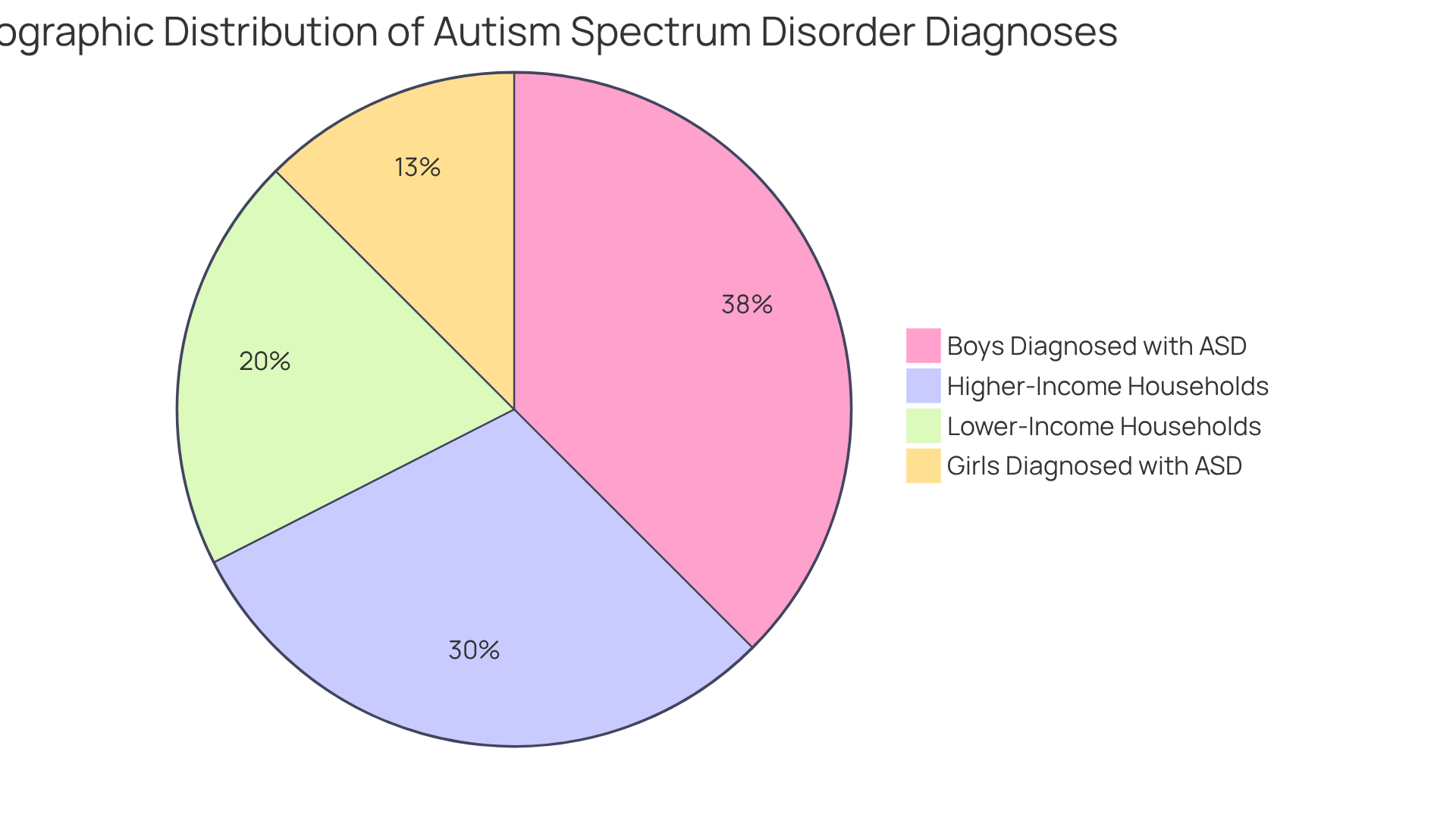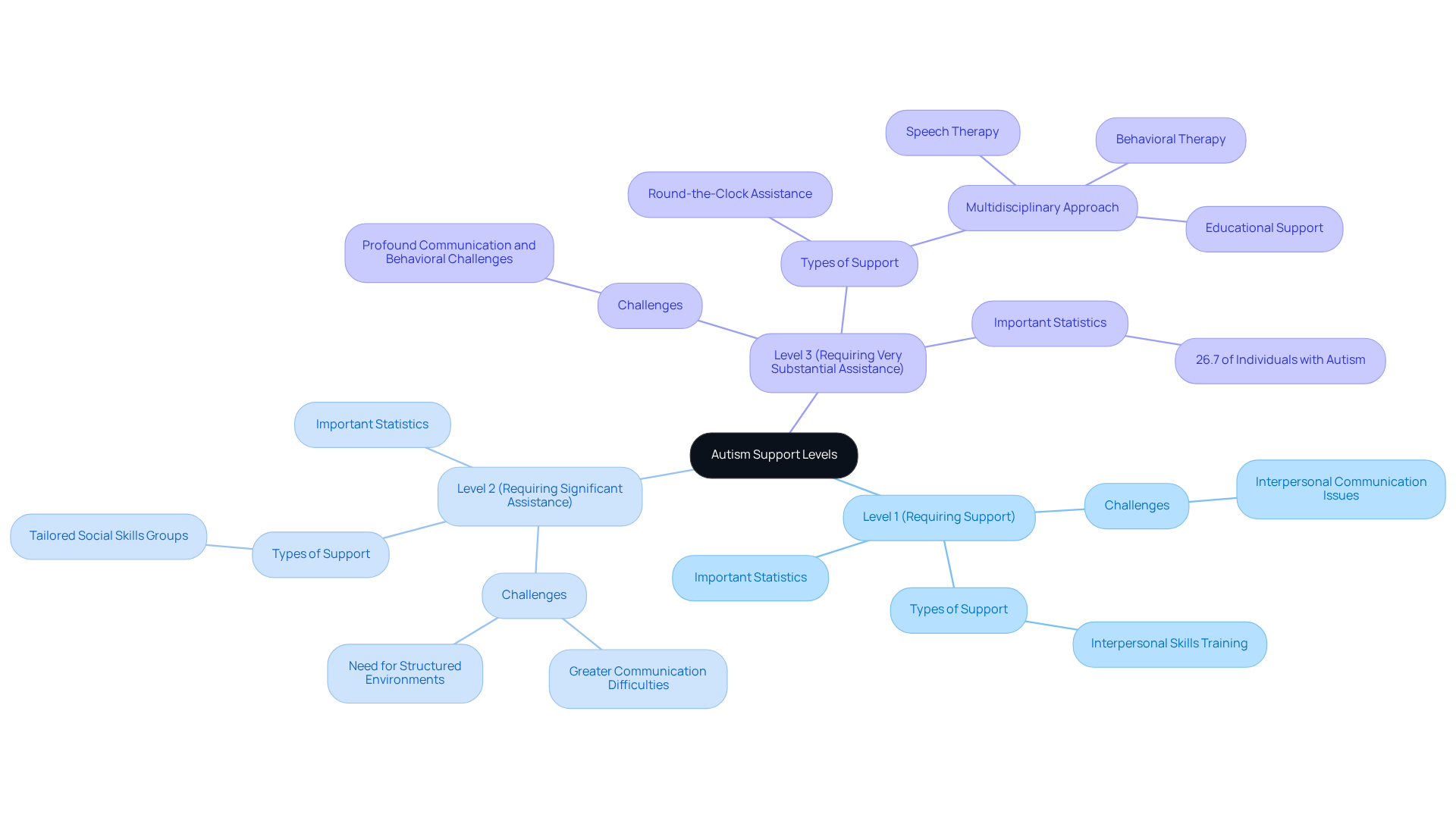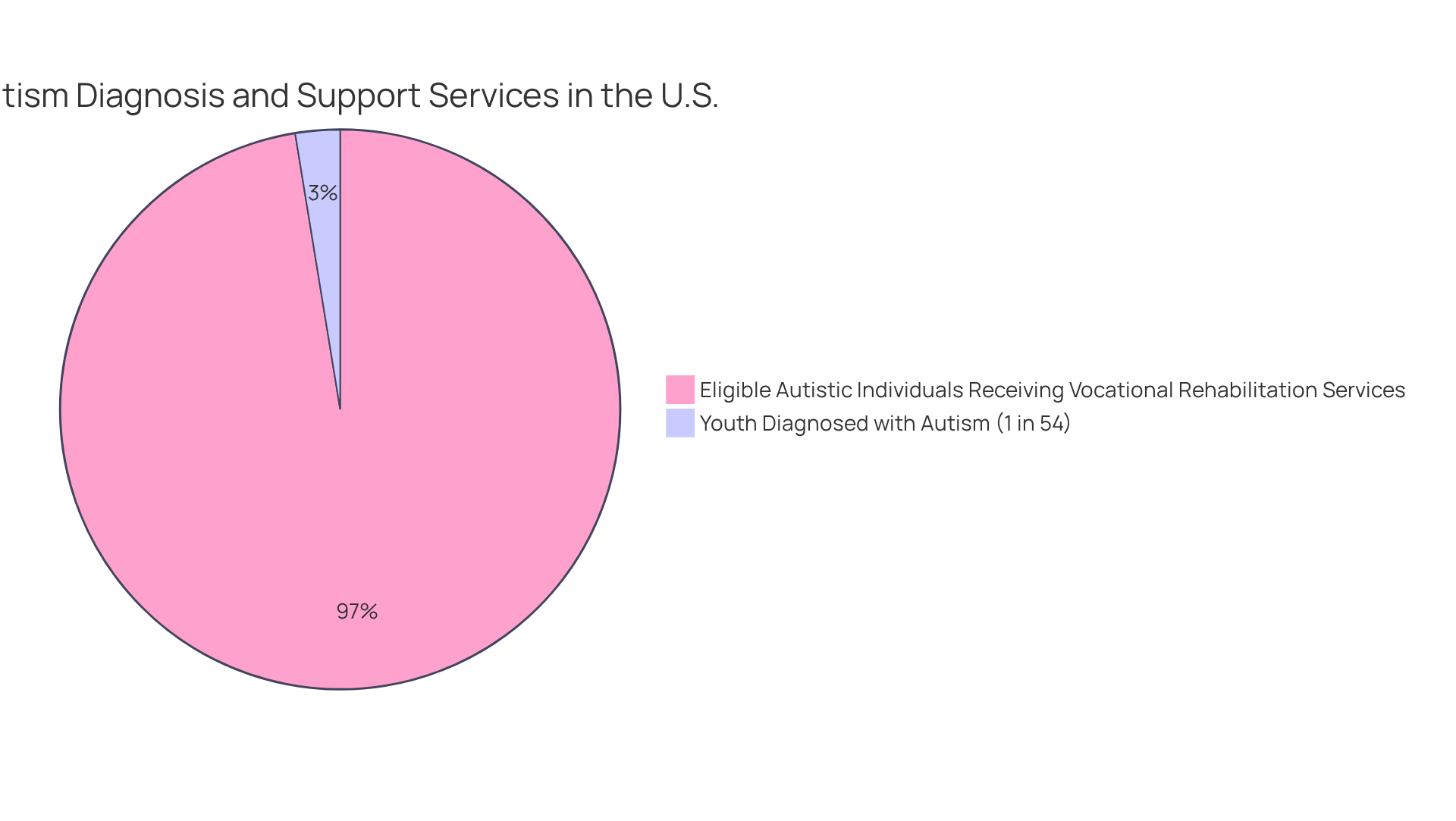Overview
This article invites you to explore the vital topic of autism support levels, aiming to develop effective strategies for individuals with Autism Spectrum Disorder (ASD). It thoughtfully categorizes autism into three levels:
- Requiring assistance
- Considerable help
- Significant help
This classification underscores the importance of personalized support strategies that address the unique challenges and strengths of each individual. Supported by statistics on prevalence and the critical role of early diagnosis, the article emphasizes that tailored support can lead to better outcomes. Together, we can foster a deeper understanding and create a supportive environment for those navigating the complexities of ASD.
Introduction
Autism Spectrum Disorder (ASD) is a multifaceted neurodevelopmental condition that affects millions, presenting a unique set of challenges in social communication and behavior. With the recent rise in diagnoses—approximately 1 in 36 children—understanding the varying support levels is more critical than ever for parents and professionals alike. This article delves into the three distinct autism support levels, offering insights into tailored strategies that can significantly enhance the quality of life for individuals on the spectrum.
How can recognizing these levels transform the way support is provided, ensuring that every child receives the personalized assistance they need to thrive?
Define Autism and Its Spectrum
Autism Spectrum Disorder (ASD) is a complex neurodevelopmental condition that presents enduring challenges in social communication, along with restricted interests and repetitive behaviors. The spectrum nature of ASD means that individuals can exhibit a wide range of symptoms and abilities, from mild to severe. Understanding this spectrum is crucial for parents and professionals, as it directly impacts the type and intensity of support required.
According to the DSM-5, autism support levels categorize autism into three levels based on symptom severity and the extent of assistance needed:
- Level 1 (requiring assistance)
- Level 2 (requiring considerable help)
- Level 3 (requiring significant help)
Each level highlights the unique challenges and strengths of the individual, emphasizing the need for personalized support strategies.
Recent statistics reveal that approximately 1 in 36 children are diagnosed with ASD, a notable increase from 1 in 44 in 2021. This rise in prevalence is significant, and it varies across different demographics; for example, boys are diagnosed at a rate over three times higher than girls. Additionally, there are disparities in diagnosis timing. Youths from lower-income households are diagnosed at an average age of 4.7 years, compared to 5.2 years for those from higher-income families. Alarmingly, Black children are five times less likely than White children to receive early intervention services, underscoring the inequities in access to support.
Understanding these nuances is vital for developing effective strategies and support systems that cater to the diverse needs of individuals on the spectrum. By fostering awareness and advocating for equitable access to resources, we can create a more inclusive environment for all families affected by ASD.

Explore the Three Levels of Autism Support
For caregivers and professionals aiming to provide the best care for individuals on the spectrum, understanding autism support levels is essential. The DSM-5 outlines three distinct autism support levels, each reflecting varying degrees of need, and recognizing these autism support levels can make a significant impact on the lives of those affected.
Level 1 (Requiring Support): Individuals at this level often encounter challenges with interpersonal communication. While they generally have the capacity for independent living, they may benefit from focused assistance, such as interpersonal skills training, to enhance their interactions. Imagine a young adult navigating social situations with a little extra guidance—this support can pave the way for more fulfilling relationships.
Level 2 (Requiring Significant Assistance): Those categorized as Level 2 face greater challenges in communication and require considerable help for daily tasks. Structured environments with clear expectations are crucial for helping them manage interactions and behaviors effectively. Real-life interventions, like tailored social skills groups, have shown promise in improving their engagement and confidence. Think about how a supportive community can transform their experiences—it's all about fostering connections.
Level 3 (Requiring Very Substantial Assistance): Individuals at this level experience profound challenges in communication and behavior, necessitating intensive help. They often require round-the-clock assistance and benefit from a multidisciplinary approach that includes behavioral therapy, speech therapy, and educational support. Recent data from the CDC, reported on April 19, 2023, indicates that approximately 26.7% of individuals with a spectrum disorder fall into this category. Judith Ursitti, co-founder of the Profound Autism Alliance, emphasizes, "Individuals with profound developmental disorders consistently face unique, devastating, and often unseen challenges that demand prompt solutions."
Comprehending autism support levels is vital for customizing strategies effectively, ensuring that each individual receives the suitable assistance to thrive. It's also important to recognize that health issues during pregnancy and childbirth may increase a child's risk of developmental disorders by 44%. This statistic underscores the importance of early intervention strategies, reinforcing that proactive support can lead to better outcomes. Together, we can make a difference in the lives of those we care for.

Implement Effective Support Strategies Based on Autism Levels
Effective support strategies must be tailored to the specific autism support levels to ensure that interventions are both relevant and impactful.
For autism support levels, Level 1 should focus on enhancing social skills through role-playing and social stories. Promoting involvement in group activities encourages interaction among individuals, while visual aids such as schedules and reminders assist people in managing transitions and expectations efficiently.
When we move to the autism support levels of Level 2, implementing structured routines is crucial. Clear communication, supported by visual aids and interaction guidelines, guides interactions and reduces confusion. Positive reinforcement strategies can motivate individuals to engage in desired behaviors. Collaboration with educators to create an inclusive classroom environment enhances learning opportunities and social integration. Recent studies suggest that organized routines greatly enhance results for individuals with Level 2 autism, with visual aids being a crucial element in boosting comprehension and adherence.
For autism support levels, intensive assistance is essential at Level 3, often requiring a multidisciplinary team of professionals. A combination of ABA therapy, speech therapy, and occupational therapy tailored to the individual's unique needs is vital. Establishing a safe and predictable environment helps reduce anxiety and promotes effective learning. Consistent communication with caregivers and family members ensures continuity of care and support, which is critical for long-term success.
Insights from ABA therapists emphasize the importance of personalized approaches, highlighting that effective strategies can lead to substantial improvements in communication and social skills. It is crucial to note that only 15% of insured minors referred for ABA-based behavioral health therapy received 80% or more of the suggested treatment hours, underscoring the need for consistent and sufficient therapy for effective results. Moreover, ABA therapy has an over 89% success rate in treating children with ASD, reinforcing the effectiveness of the strategies discussed.
Early intervention is also crucial, as it has shown improvements in communication abilities and cognition when therapy starts around age two. Lastly, the average expense of supporting an individual with developmental disorders is approximately $60,000 annually throughout their childhood, emphasizing the significance of effective support strategies in managing long-term costs related to care.

Recognize the Importance of Early Diagnosis and Customized Support
Recognizing the signs of autism early is vital for your child's development. Early identification allows for prompt intervention, which can significantly improve outcomes. Research shows that children diagnosed before the age of 2.5 years are more likely to see advancements in communication, social skills, and behavior. In fact, about 1 in 54 youth in the United States is diagnosed with autism spectrum disorder (ASD), underscoring the urgent need for early detection.
To ensure effective intervention, personalized support strategies tailored to each child's unique needs are essential. These strategies should adopt a multidisciplinary approach, bringing together insights from therapists, educators, and family members to form a unified support system. By recognizing developmental disorder indicators early and pursuing appropriate evaluations, parents can access vital resources and support for their children to thrive.
The American Academy of Pediatrics stresses the importance of early screenings at 18 and 24 months, which can lead to timely interventions. This highlights how critical early diagnosis is in autism research. Real-life examples illustrate that personalized assistance plans can significantly enhance children's daily functioning and quality of life. For instance, 70% of eligible autistic individuals in the U.S. receive vocational rehabilitation services, showcasing effective support systems in action.
Moreover, around 26.7% of autistic 8-year-olds in the U.S. experience profound autism, highlighting the diverse autism support levels required and reinforcing the necessity for tailored intervention strategies. By taking these steps, you can help your child navigate their unique challenges and flourish.

Conclusion
Understanding the varying levels of autism support is essential for fostering an inclusive environment where individuals on the spectrum can truly thrive. By recognizing the distinct needs associated with Level 1, Level 2, and Level 3 support, caregivers and professionals can tailor their strategies. This ensures that each individual receives the appropriate assistance to enhance their quality of life.
The article highlights the importance of personalized support strategies, emphasizing the need for early diagnosis and intervention. From enhancing social skills for those at Level 1 to providing intensive, multidisciplinary support for individuals at Level 3, the insights shared underscore how customized approaches can lead to significant improvements in communication and daily functioning. Moreover, the disparities in diagnosis and access to services reveal the pressing need for equitable support systems that cater to all families affected by autism.
Ultimately, the journey towards effective autism support begins with awareness and advocacy. By prioritizing early detection, understanding the nuances of each support level, and implementing tailored strategies, communities can create a more inclusive environment. This empowers individuals with autism to reach their full potential. Taking action today can lead to transformative outcomes, ensuring that every child receives the support they need to flourish.
Frequently Asked Questions
What is Autism Spectrum Disorder (ASD)?
Autism Spectrum Disorder (ASD) is a complex neurodevelopmental condition characterized by enduring challenges in social communication, along with restricted interests and repetitive behaviors.
How is ASD categorized in terms of severity?
ASD is categorized into three levels based on symptom severity and the extent of assistance needed: Level 1 (requiring assistance), Level 2 (requiring considerable help), and Level 3 (requiring significant help).
Why is understanding the spectrum of ASD important?
Understanding the spectrum of ASD is crucial for parents and professionals as it directly impacts the type and intensity of support required for individuals, highlighting their unique challenges and strengths.
What are the current statistics on ASD diagnoses?
Approximately 1 in 36 children are diagnosed with ASD, which is an increase from 1 in 44 in 2021.
Are there demographic differences in ASD diagnoses?
Yes, boys are diagnosed with ASD at a rate over three times higher than girls. Additionally, there are disparities in diagnosis timing based on income, with youths from lower-income households diagnosed at an average age of 4.7 years compared to 5.2 years for those from higher-income families.
What disparities exist in access to early intervention services for ASD?
Black children are five times less likely than White children to receive early intervention services, highlighting inequities in access to support.
Why is it important to advocate for equitable access to resources for individuals with ASD?
Advocating for equitable access to resources is vital for developing effective strategies and support systems that cater to the diverse needs of individuals on the spectrum, fostering a more inclusive environment for all families affected by ASD.




